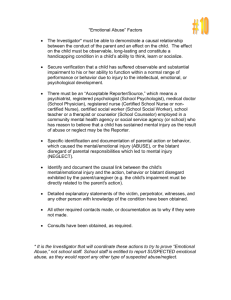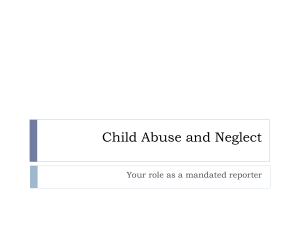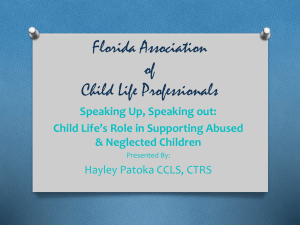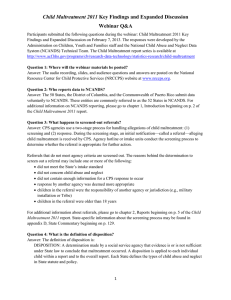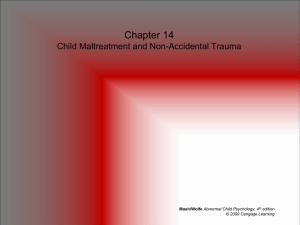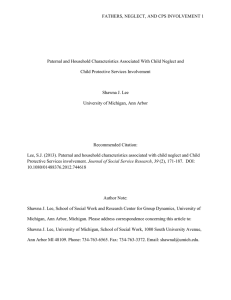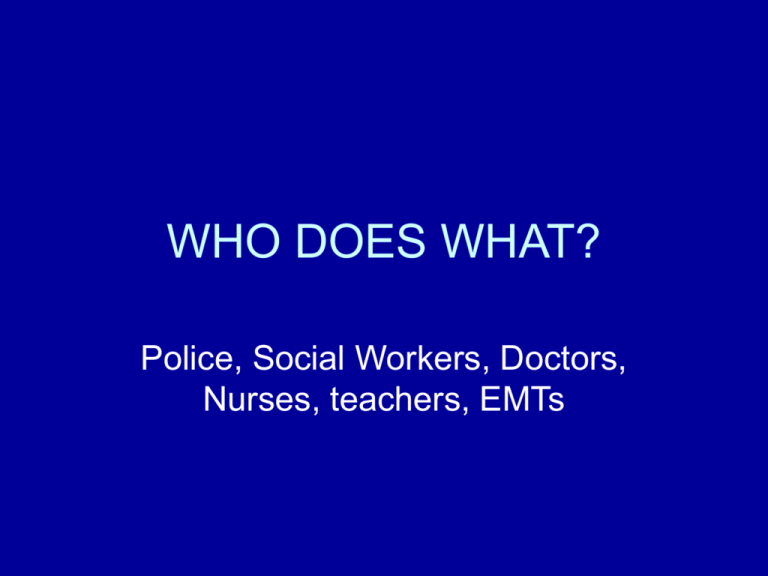
WHO DOES WHAT?
Police, Social Workers, Doctors,
Nurses, teachers, EMTs
LAW ENFORCEMENT
• Safety of the public/children
– What actions are necessary from a law
enforcement standpoint to protect the child?
– Are other children at risk?
• Preservation & collection of evidence for the
purpose of criminal prosecution
• Substantiate report with corroborating
evidence
•
•
•
•
•
•
•
Law Enforcement Agency Roles
in Response to Child
Maltreatment
Deterrence
Prevention & Advocacy
Reporting
Immediate Response
Criminal Investigative Role
Support to CPS
Victim Support
Ideal Training
• Understanding needs of children &
families
• Issues related to child abuse & neglect
• Cognitive & language development of
children
• Non-abusive causes of findings
resembling maltreatment
• Typical patterns of disclosure commonly
seen in child maltreatment
• Note: disclosure is seldom deliberate;
comes to attention of authorities by
observed symptoms or injuries
What makes child
maltreatment different?
• Children can’t protect themselves
• CM usually done in private with few if any
witnesses
• Kept secret
• Children not believed
• Community also may not want to believe
• Interviews with children require special
training
• Children often don’t tell, delayed
disclosure, or piecemeal
• Children have conflicting feelings about
disclosure & the perpetrator
• Maltreatment often abnormal caregiving
behavior rather than an isolated incident
• Sexual abuse often leaves NO physical
or medical evidence
• Involves joint investigation with CPS:
causes ambiguities & potential conflicts
• Some cases cross jurisdictional
boundaries making determination of
venue difficult for investigators
• Criminal justice system may not be
sensitive to children
• Note: Success of a team is not
measured by the lack of conflict, but
the effectiveness with which conflict is
resolved
• CPS reports 20% of cases joint; law
enforcement agencies 80-95% cases
joint; most seen in sexual abuse cases
• Should have formal CPS/law
enforcement protocols
Police actions
•
•
•
•
•
Collecting & preserving evidence
Examining crime scenes
Taking statements
Securing confessions
Ability to make arrests
• Appropriate response to calls based on
urgency of situation, stabilization of
crime scene, taking initial statement
• Interviewing child victims
• Facilitating use of special investigative
tools,e.g., monitoring phone calls
• MN allows cold calls
• Conducting criminal history record
checks for alleged perpetrators
• Presenting evidence in criminal cases
• Testifying in court
• Taking the child into protective custody
if the child’s safety is at risk
• Note: interview of victim or witness
should be in neutral place-not the
location of abuse or police station
• Interviewer should minimize size
difference between self & child
• Example: parent said child climbed on
stool & turned on water & burnt hand
• Officer went to home & discovered this
would be impossible: facet to far away
for child to turn on
SOCIAL WORKERS
• 1. Family investigation/traditional
response
• 2. Family assessment/informal
response
• 3. Ongoing supervision/work with family
• 4. Child welfare agency work: homebased services
NURSES
• May see abuse/neglect during:
• Routine home visits by public health &
home health nurses
• Clinic, office, or emergency department
• In-patient hospital units
• Schools & camps
• Advanced practice: clinical nurse
specialists, nurse practitioners
• SANEs: Sexual Assault Nurse
Examiners
Evaluate for Child
Maltreatment Suspicions
•
•
•
•
Historical details provided
Physical signs uncovered
Laboratory & diagnostic testing data received
Family background/cultural practices
observed
• Child’s expected developmental level &
abilities
Areas of responsibility along
with physician
• Interviewing child for medical history
• Examining child for physical findings &
collecting forensic evidence when
appropriate
• Ordering & interpreting appropriate
laboratory & diagnostic tests
• Observing interactions between child &
family
• Generating differential diagnoses
• Carefully documenting findings of a
complete healthcare evaluation
Building Blocks
•
•
•
•
Physical examination
History
Laboratory
Observed interaction
• Note: If the presentation, history, &
injury do not seem concordant or have
characteristics that do not make sense,
the level of suspicion is raised to the
point of reporting information to CPS
• Note: careful documentation of
caregiver’s account is crucial; story may
change over time
Differentiating Accident from
Inflicted Injuries
•
•
•
•
•
•
Magical injuries
Changing history of injury
History incongruous with injury
Developmentally incompatible history
Self-inflicted trauma history
Young sibling or playmate blamed
• Delayed presentation/late medical care
• Caregiver who was watching the child
does not come to the hospital
• Any pattern that shows child might have
been restrained
• History of previous injury
• Signs & symptoms of neglectful
caregiving including poor hygiene,
malnutrition
• Under age 2, suspected abuse, do
skeletal survey: complete set of
radiographs
Dating skeletal injuries
• Recognize: soft tissue changes, visibility
of fracture line, callus calcification &
ossification of new periosteal bone
Sexual abuse signs
• Physical complaints: specific: genital
injury; bruises & lacerations; rectal
laceration; fissures; STDs; pregnancy
• Nonspecific: anorexia, abdominal pain,
enuresis, dysuria, encopresis, evidence
of physical abuse in genital area,
vaginal discharge, urethral discharge,
rectal pain
• Behavioral complaints: specific: explicit
descriptions of sexual contact;
inappropriate knowledge of adult sexual
behavior
• Compulsive masturbation
• Excessive sexual curiosity, sexual
acting out
• Nonspecific: excessive fears, phobias,
refusal to sleep alone, nightmares,
runaways, aggressive behavior,
attempted suicide, any abrupt change in
behavior
Other causes
• Chemical irritation from harsh
soaps,frequent bubble baths, etc.
• Mechanical irritation: tight clothing,
nylon underpants, wet bathing suits
Neglect
• Provisional neglect: food, clothing,
shelter, healthcare
• Developmental neglect: child not
provided with appropriate stimulating
environment
• Supervisional neglect: child not
protected from environmental hazards
• Most common: FTT: child falls below 3rd
or 5th percentile for height &/or weight,
or child shows drop in 2 percentiles
between health visits
• Developmental neglect may manifest by
child not making eye contact, resistant
to being held, inability to relate to the
nurse
Bruises
• Typically accidental: forehead, elbow,
knees, shins, iliac crest
• Possibly nonaccidental: scalp, behind
ears, neck, axillae, inner thighs, webs of
fingers/toes, genitalia
• Location of bruises, shape of bruises, &
amount & extent of bruising
• In describing bruises: DETAIL: pattern
of injury, shape, dimensions, pattern,
color variability
• Time cannot be decided
• Could be cupping, coining, Mongolian
spots
Burns
• Scalding, splash, immersion, contact
Other Roles
• Prevention
• Mental health
• Research activities
Teachers
• In some states teachers or other
mandated reporters may be convicted
of not reporting even if they do not know
about the law
• Individuals & school districts, in some
states, may be sued civilly for not
reporting
• Most school districts have a policy
about reporting; know your policy
• Schools should have protocol for
reporting institutional abuse
• Some states require both a criminal
check & a child abuse & neglect hotline
check for employees
To avoid hiring an abuser
• Do above, plus:
• Interviews with at least two different
people asking such questions as What
children’s behaviors make you angry
and how do you cope with that anger?
Give a couple of examples of situations
in which you were successful in
disciplining a child.
• The interviewer can only ask questions
related to the job.
• Do reference checks: ask such
questions as When & where was the
applicant observed working with
children? How does the applicant
handle criticism & frustration on the job?
• Have in-service training
• Supervise volunteers
What to observe in a child?
• Only one-fourth of children abused are
aggressive & negative-acting out
behavior
• Three-fourths are over compliant &
appear to accept whatever happens to
them; very sensitive to criticism & need
only mild suggestions
Teachers can:
• Create a calm, structured environment
• Be trustworthy: do what you say you will
do; abused children have trust issues
• Be consistent
• Expect success
• Teach/model social skills, life skills,
communication skills
• Allow students to be students; many
neglected/abused children aren’t
allowed to be children; some take over
the role of parent
•
•
•
•
Teach positive coping skills
Provide pleasant experiences
Build self-esteem
Improve academic skills
Resiliency of Children
• Children who recover have the following
4 characteristics:
• 1. A good approach to solving life’s
problems; they can negotiate
successfully bad experiences
• 2. Tendency to experience experiences
constructively
• 3. Ability to gain other people’s positive
attention
• 4. Strong ability to use faith in order to
maintain positive vision of a meaningful
life
EMTs & other first responders




